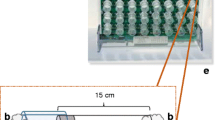Abstract
The influence of female and male cues on the male searching behavior of the sheep tick, Ixodes ricinus (Acari: Ixodidae), was studied under constant laboratory conditions by means of a computerized video tracking system. Males were released into an open glass arena in which one half had been exposed for 1 h to 5 freely walking unfed females or five males. The obtained track data were analyzed to reveal if male walking pattern was random or affected by cues of conspecifics left on the arena surface. The results showed that males spent significantly more time and walked a significantly longer distance in the area with female cues compared to the control area. Moreover, the walking path of males was more tortuous on the cues half than the control half. In contrast, walking behavior of males was not affected by male cues in any observed parameter. These results provide the first evidence that unfed females leave sex-specific semiochemicals on a substrate during their walk and that these cues have an effect on male searching behavior. Since this effect was not observed when female cues were 24-h old, the semiochemicals seem to either evaporate or are subject to degradation. The biological significance of these findings for mate-searching in I. ricinus males is discussed.




Similar content being viewed by others
References
Babenko LV, Bush MA, Arumova EA, Skadinsh EA (1979) Seasonal changes in the fertility level of female ixodus ricinus L. and ixodus persulcatus p. sch. before finding hosts and the importance of this phenomenon in the life of the tick population. Med Parazitol Bol 48:71–79 (In Russsian)
Bell WJ (1991) Searching behaviour: the behavioural ecology of finding resources. Chapman & Hall, London
Bouman EAP, Zemek R, Dusbábek F, Socha R (1999) Sexual behaviour of the sheep tick, Ixodes ricinus (L.) (Acari, Ixodidae). In: Robinson WH, Rettich F, Rambo GW (eds) Proceedings of the 3rd International Conference on Urban Pests, Czech University of Agriculture, Prague, Czech Republic, 19–22 July 1999, Grafické závody, Hronov, Czech Republic, pp 255–260
Bouman EAP, Dusbábek F, Šimek P, Zahradníčková H (2003) Methyl 3-chloro-4-methoxybenzoate, a new candidate semiochemical inhibiting copulation behaviour of Ixodes ricinus (L.) males. Physiol Entomol 28:276–282
Dobrotvorsky AK, Tkachev AV (1995) Evidence of a volatile sex pheromone in unfed adult taiga tick Ixodes persulcatus Schulze. In: Coons L, Rotschild M (eds) Proceedings and abstracts of the 2nd international conference on Tick-Borne pathogens at the host–vector interface: a global perspectives. Kruger Nat. Park, South Africa, August 28–September 1, 1995, United Litho, pp 372–378
Dusbábek F, Šimek P, Bouman EAP, Zahradníčková H, Zemek R (2001) The composition and effect of several semiochemicals in Ixodes ricinus (L.) (Acari: Ixodidae). In: Buczek A, Blaszak C (eds) Proceedings of the 2nd International Symposium “Stawonogi pasozyty i nosiciele”, Wyd. KGM, Lublin, pp 33–43
Graf JF (1975) Ecologie et éthologie d’Ixodes ricinus L. en Suisse (Ixodoidea: Ixodidae) Cinquième note: Mise un évidence d’une phéromone sexuelle chez I. ricinus. Acarologia 17:437–441
Graf JF (1978a) Copulation, nutrition et ponte chez Ixodes ricinus L. (Ixodoidea: Ixodidae) – 2e partie. Bull Soc Entomol Suisse 51:241–253
Graf JF (1978b) Copulation, nutrition et ponte chez Ixodes ricinus L. (Ixodoidea: Ixodidae) – 3e partie. Bull Soc Entomol Suisse 51:343–360
Gray JS (1987) Mating and behavioural diapause in Ixodes ricinus L. Exp Appl Acarol 3:61–71
Guerin PM, Kröber T, McMahon C, Guerenstein P, Grenacher S, Vlimant M, Diehl PA, Steullet P, Syed Z (2000) Chemosensory and behavioural adaptations of ectoparasitic arthropods. Nova Acta Leopoldina 83:197–213
Jaccard J, Wan CK (1996) LISREL approaches to interaction effects in multiple regression. Sage Publications, Thousand Oaks, California
Kröber T, Guerin PM (1999) Ixodid ticks avoid contact with liquid water. J Exp Biol 202:1877–1883
McMahon C, Guerin PM (2002) Attraction of the tropical bont tick, Amblyomma variegatum, to human breath and to the breath components acetone, NO and CO2. Naturwissenschaften 89:311–315
Mikulová N, Dusbábek F, Bouman EAP (2005) Mating activity and physiological age of females in population of Ixodes ricinus (L.) (Acari: Ixodidae). Acarina 13:85–92
Noldus LPJJ, Spink AJ, Tegelenbosch RDJ (2002) Computerised video tracking, movemenent analysis and behaviour recognition in insects. Comp Electr Agric 35:201–227
Noldus Information Technology (1997) EthoVision: Video Tracking, Motion Analysis & Behavior Recognition System. Reference Manual, Version 1.90. Wageningen, The Netherlands
SAS Inst (2000) The SAS System for Linux, release 8.2. SAS OnlineDoc, Version 8. SAS Institute Inc., Cary, NC, USA
Siegel S, Castellan NJJ (1988) Nonparametric statistics for the behavioral sciences. McGraw-Hill Book Company, New York, NY, USA
Sonenshine DE (1991) Biology of ticks. Vol 1. Oxford University Press, New York
Sonenshine DE (2006) Tick pheromones and their use in tick control. Ann Rev Entomol 51:557–580
Sonenshine DE, Hamilton JG, Phillips JS, Lusby WR (1991) Mounting sex pheromone: its role in regulations of mate recognition in the Ixodidae. In: Dusbábek F, Bukva V (eds) Vol 1. Modern acarology. Academia and SPB Academic Publishing bv, Prague, The Hague, pp 69–78
Tkachev A, Dobrotvorsky AK, Vjalkov AI, Morosov SV (2000) Chemical composition of lipophylic compounds from the body surface of unfed adult Ixodes persulcatus ticks (Acari: Ixodidae). Exp Appl Acarol 24:145–158
Zemek R, Bouman EAP, Socha R, Dusbábek F (2002) The effect of feeding status on sexual attractiveness of Ixodes ricinus (Acari: Ixodidae) females. Exp Appl Acarol 27:137–149
Acknowledgements
This work was supported by grant No. 206/04/0751 from Czech Science Foundation, grant No. A6007303 from Grant Agency of the Academy of Sciences of the Czech Republic and partially by the Institutional Research Project of the Institute of Entomology No. Z50070508 and Institute of Parasitology No. Z60220518 (Acad. Sci. CR). The authors thank Dr. Blanka Kalinová for discussion and valuable comments to the first draft of manuscript. Mr. Jan Erhart and Mrs. Jana Jabůrková are thanked for their technical assistance.
Author information
Authors and Affiliations
Corresponding author
Rights and permissions
About this article
Cite this article
Zemek, R., Bouman, E.A.P. & Dusbábek, F. The influence of conspecific chemical cues on walking behavior of Ixodes ricinus males. Exp Appl Acarol 41, 255–265 (2007). https://doi.org/10.1007/s10493-007-9067-0
Received:
Accepted:
Published:
Issue Date:
DOI: https://doi.org/10.1007/s10493-007-9067-0




